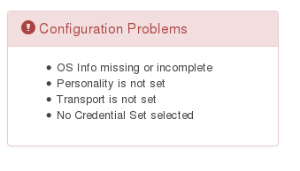...
CREDENTIAL SETS:
- Credential sets are a combination of usernames, passwords, access protocols (ssh, telnet), privilege modes etc. allowing access to the devices CLI.
- Once the credential set has been used to create a working CLI access then "commands" can be issued and the results recorded.
COMMAND SETS
Commands are normally command line constructs which will be executed on the node in question.
(Some are "passive commands" like "audit-import" which are not actually run on the node but the result is associated with node.
Commands can be grouped and collected into what opConfig calls a "command set". Command sets are conured configured to apply only to particular platforms or OS and maybe versions or platforms.
The command output is captured and stored by opConfig.
Command outputs are compared against the previous revision, and if different it's saved as a new revision in opConfig. e.g.a one It could also be a one-shot command which is not analyzed in great detail (e.g. a process listing or some other diagnostic command)
A command can be marked for change detection in which case more detailed analysis occurs for changes.
CHANGES / REVISIONS:
Command outputs can be maked marked for change detection (e.g. a listing of installed software), in which case opConfig creates detailed records of what the changes are - again only if there are differences between the current command output and the most recent revision for this command.
- Revisions are the time series of the command outputs and there changes.
Adding
...
Credential Sets, Managing Credential Sets
Credentials for all connections made by opConfig are configurable from the opConfig GUI ONLY. Before anything else you need to create sets of credentials to access you devices. At this point in time, opConfig supports only Telnet and SSH, and for SSH only password-based authentication is supported.
...
The problem reports are fairly self-explanatory (and clickable).
- .And, last but not least: interactive connections to nodes clearly require s, hence you must tell opConfig which Credential Set should apply to your new node
The following is a breakdown on the information opConfig uses about the device.
- General TAB - This is generic information about the device and is the information imported from NMIS / OpenAudit. Only the host entry needs to be correct here, and it must be a usable FQDN or IP address.
- Connection TAB - To connect to a node, opConfig needs to know some information about it
- Personality this is the CLI Parsing to use to enable the issuing of commands e.g. line endings, prompts etc. The Personality includes information about the prompts, line-ending conventions etc. a node is subject to; for example, the 'ios' personality handles understanding the > prompt and "enable" command and "bash" understands shell prompts. The personalities supported are available in the drop down.
- CredentialSet - NOT automatic and needs to be set - authentication and authorization in the form of the access credential set created earlier.
- Transport (Telnet or SSH) - NOT automatic and needs to be set
- OS info TAB - Once connected to a node we need to know the OS and maybe version, subversion, platform in use to select the right commands to issue and how to parse the command results. This where COMMAND SETS ("command_sets.nmis" file) that opConfig uses are associated to , makes association between the OS and maybea maybe a version and maybe a major release or train and the command to issue and how to parse it.
- These fields should be automatically populated if your device was discovered by NMIS or OpenAudit if they are Cisco IOS or Linux devices
- The OS field and potentially the version and other fields must match the 'os' => and any 'version' => fields in the command_sets.nmis file.
Import (and discovery) from the Command Line
...
